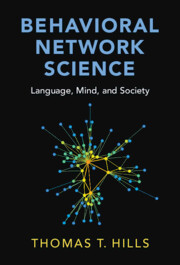Book contents
- Frontmatter
- Contents
- Additional Resources
- Introduction: Structure Matters
- Part I A Brief Guide to Network Science
- Part II Language
- Part III Mind
- 10 False Memories: Spreading Activation in Memory Networks
- 11 Cognitive Foraging: Exploration versus Exploitation
- 12 Age-Related Cognitive Decline: A Network Enrichment Account
- 13 Creativity: How Noisy Processes Create Novel Structure
- Part IV Society
- References
- Index
12 - Age-Related Cognitive Decline: A Network Enrichment Account
from Part III - Mind
Published online by Cambridge University Press: 08 November 2024
- Frontmatter
- Contents
- Additional Resources
- Introduction: Structure Matters
- Part I A Brief Guide to Network Science
- Part II Language
- Part III Mind
- 10 False Memories: Spreading Activation in Memory Networks
- 11 Cognitive Foraging: Exploration versus Exploitation
- 12 Age-Related Cognitive Decline: A Network Enrichment Account
- 13 Creativity: How Noisy Processes Create Novel Structure
- Part IV Society
- References
- Index
Summary
There are two contrasting views of aging. One sees age as a process of cognitive decline, a natural consequence of biological aging. The other sees aging as a process of lifelong learning: Older adults show conspicuous improvements in vocabulary across the lifespan as well as in many other knowledge-related domains. Of these two views, one is based on an underlying process of decay. The other is based on enrichment. Here we will investigate how understanding the nature of structural changes across the lifespan can help align these views, demonstrating how age related cognitive decline can be explained as a process of network enrichment caused by lifelong learning.
Keywords
Information
- Type
- Chapter
- Information
- Behavioral Network ScienceLanguage, Mind, and Society, pp. 184 - 202Publisher: Cambridge University PressPrint publication year: 2024
